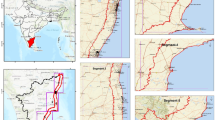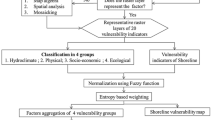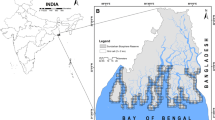Abstract
Climate change-induced marine hazards are increasingly threatening coastal zones, with a two-fold increase in the last decade. In this study, we assessed coastal vulnerability using the multi-criteria decision making (MCDM) method in conjunction with geospatial applications. Data on five physical variables: geomorphology, coastal slope, shoreline change history, spring tide range and significant wave height were extracted from the optical and microwave remote sensing images, existing maps and GIS processing for the 78-km-long coastal zone of Kozhikode district, which was taken as a case study. Weighted analysis of these variables and their subunits was performed using the analytical hierarchical method. These data were then processed to calculate the coastal vulnerability index (CVI), which ranged between 0.06 and 0.44 for the study area with higher CVI values indicating higher risk of hazards. The coastal risk analysis made using the geometric interval classification of the entire range of CVI values indicated that more than a third of the Kozhikode coast is under high risk to coastal hazards. Our study demonstrated the importance of integrating geospatial and MCDM analysis for a robust coastal vulnerability assessment in determining the hazard proneness of different coastal segments.






Similar content being viewed by others
References
Adams WJL, Saaty R (2003) Super decisions software guide. Super Decis 9:43
Ahmed N, Howlader N, Hoque MA-A, Pradhan B (2021) Coastal Vulnerability Assessment along the eastern coast of Bangladesh using geospatial techniques. Ocean Coast Manag 199:105408
Ali PY, Narayana AC (2015) Short-term morphological and shoreline changes at Trinkat Island, Andaman and Nicobar, India after the 2004 tsunami. Mar Geodesy 38:26–39
Andersen JH, Al-Hamdani Z, Harvey ET et al (2020) Relative impacts of multiple human stressors in estuaries and coastal waters in the North Sea-Baltic Sea transaction zone. Sci Total Environ 704:135316
Antonioli F, Falco GD, Presti VL et al (2020) Relative sea-level rise and potential submersion risk for 2100 on 16 coastal plains of the Mediterranean sea. Water 12:2173
Appeaning Addo K (2014) Coastal Vulnerability Index to Sea Level Rise in Ghana. Coastal and Marine Research 2(1):1. https://doi.org/10.12966/cmr.01.01.2014
Arns A, Wahl T, Wolff C et al (2020) Non-linear interaction modulated global extreme sea levels, coastal flood exposure, and impacts. Nat Commun 11:1–9
Bagheri M, Ibrahim ZZ, Mansor SB et al (2019) Shoreline change analysis and erosion prediction using historical data of Kuala Terengganu, Malaysiua. Environ Earth Sci 78:477
Baig MRI, Ahmad IA, Shahfahad et al (2020) Analysis of shoreline changes in Visakhapatnam coastal tract of Andhra Pradesh, India: an application of digital shoreline analysis system (DSAS). Ann GIS 26:361–376
Barros JL, Santos AE, Tavares AO (2015) Composite methodology for tsunami vulnerability assessment based on the numerical simulation of 1755 Lisbon tsunami-application on two Portuguese coastal areas Safety and Reliability: Methodology and Applications-Nowakowski et al. (Eds), pp.1581–1588
Bini M, Rossi V (2021) Climate change and anthropogenic impact on coastal environments. Water 13:1182
Boruff B, Emrich C, Cutter SL (2005) Erosion hazard vulnerability of US casotal countries. J Coastal Res 21(5):932–942
Broadhead J, Leslie R (2007) Coastal protection in the aftermath of the Indian Ocean tsunami: What role for forests and trees? Rap publication 219. https://www.fao.org/documents/card/es/c/e453fd03-505c-5f7e-af5b-6135fd72d873/. Accessed 5 Sep 2021
Davis R Jr, Fitzgerald DM (2009) Beaches and coasts. Wiley
Dayal KS, Deo RC, Apan AA (2018) Spatio-temporal drought risk mapping approach and its application in the drought-prone region of south-east Queensland, Australia. Nat Hazards 93(2):823–847
Deng J, Woodroffe CD, Rogers K, Harff J (2017) Morphogenetic modelling of coastal and estuarine evolution. Earth Sci Rev 171:254–271. https://doi.org/10.1016/j.earscirev.2017.05.011
Domínguez L, Anfuso G, Gracia FJ (2005) Vulnerability assessment of a retreating coast in SW Spain. Environ Geol 47:1037–1044
Environmental Systems Research Institute (ESRI) (2018) Standard classification schemes. (Online). Accessed on November 19, 2018. http://webhelp.esri.com
FitzGerald DM, Fenster MS, Argow BA, Buynevich IV (2008) Coastal impacts due to sea-level rise. Annu Rev Earth Planet Sci 36(1):601–647
Gornitz V (1991) Global coastal hazards from future sea level rise. Palaeogeogr Palaeoclimatol Palaeoecolo 89:379–439
Gornitz V, Kanciruk P (1989) Assessment of global coastal hazards from sea-level rise. Proceedings of the 6th Symposium on Coastal and Ocean management, ASCE, July 11–14, 1989, Charleston, SC
Guillard-Gonçalves C, Cutter SL, Emrich CT, Zêzere JL (2015) Application of Social Vulnerability Index (SoVI) and delineation of natural risk zones in Greater Lisbon, Portugal. J Risk Res 18:651–674
Hadipour V, Vafaie F, Deilami K (2020) Coastal flooding risk assessment using a GIS-based spatial multi-criteria decision analysis approach. Water 12:2379
Hegde AV, Reju VR (2007) Development of coastal vulnerability index for Mangalore coast, India. J Coastal Res 23:1106–1111
Hoozemans FM, Hulsbergen CH (2021) Sea Level Rise: A Worldwide Assessment of Risk and Protection Costs. Climate Change Impact on Coastal Habitation. https://doi.org/10.1201/9781003069935
Hoque MA-A, Ahmed N, Pradhan B, Roy S (2019) Assessment of coastal vulnerability to multi-hazardous events using geospatial techniques along the eastern coast of Bangladesh. Ocean Coast Manag 181:104898
Hughes P, Brundrit GB, Searson S (1992) The vulnerability of Walvis Bay to rising sea levels. J Coastal Res 8(4):868–881
IPCC (2021) Summary for Policymakers. In: Climate Change 2021: The Physical Science Basis. Contribution of working Group I to the Sixth Assessment Report of the Intergovernmental Panel on Climate Change [Masson-Delmotte V, Zhai P, Pirani A, Connors SL, Pean C, Berger S, Caud N, Chen Y, Goldfarb L, Gomis MI, Huang M, Leitzell K, Lonnoy E, Matthews JBR, Maycock TK, Waterfiled T, Yelekci O, Yu R, Hou B (eds.)]. Cambridge University Press. In press
Kaliraj S, Chandrasekhar N, Magesh NS (2014) Impacts of wave energy and littoral currents on shoreline erosion/accretion along the south-west coast of Kanyakumari, Tamil Nadu using DSAS and geospatial technology. Environ Earth Sci 71:4523–4542
Karthikeyan R, Venkatesan KGS, Chandrasekar A (2016) A comparison of strengths and weaknesses for analytical hierarchy process. J Chem Pharm Sci 9:12–15
Katikou P (2020) 8 Human impact in Mediterranean coastal ecosystems and climate change: emerging toxins. In: Climate Change and Marine and Freshwater Toxins. De Gruyter, pp 253–302
Kay R, Jaqueline Alder P (2005) Coastal Planning and Management Chinese simplifies, language. Shanghai University of Finance and Economics Press, Shanghai
Kumar AA, Kunte PD (2012) Coastal vulnerability assessment for Chennai, east coast of India using geospatial techniques. Nat Hazards 64:853–872
Kumar TS, Mahendra RS, Nayak S, Radhakrishnan K, Sahu KC (2010) Coastal vulnerability assessment for Orissa state, East Coast of India. J Coast Res 26(3):523–534
Kumbier K, Carvalho RC, Woodroffee CD (2018) Modelling hydrodynamic impacts of sea-level rise on wave-dominated Australian Estuaries with differing geomorphology. J Mar Sci Eng 6:66. https://doi.org/10.3390/jmse6020066
Lin L, Pussella P (2017) Assessment of vulnerability for coastal erosion with GIS and AHP techniques case study: Southern coastline of Sri Lanka. Nat Resource Model 30:e12146
Liu J, Wen J, Huang Y et al (2015) Human settlement and regional development in the context of climate change: a spatial analysis of low elevation coastal zones in China. Mitig Adapt Strat Glob Change 20:527–546
Mahapatra M, Ramakrishnan R, Rajawat AS (2015) Coastal vulnerability assessment of Gujarat coast to sea level rise using GIS techniques: a preliminary study. J Coast Conserv 19:241–256. https://doi.org/10.1007/s11852-015-0384-x
Mani Murali R, Ankita M, Amrita S, Vethamony P (2013) Coastal Vulnerability Assessment of Puducherry coast, India, using the analytical hierarchical process. Nat Hazard 13:3291–3311
Mehvar S, Filatova T, Dastgheib A et al (2018) Quantifying economic value of coastal ecosystem services: a review. J Mar Sci Eng 6:5
Messerli P, Murniningtyas E, Eloundou-Enyegue P et al (2019) Global sustainable development report 2019: the future is now-science for achieving sustainable development. https://sustainabledevelopment.un.org/content/documents/24797GSDR_report_2019.pdf. Accessed 24 Aug 2021
Mihoubi MK, Belkessa R, Latreche MA (2014) Study of the vulnerability of coastal area of the Algerian basin with the GIS. Int J Environ Sci Dev 5(6):522–526
Mitra D, Chandra P (2014) Coastal vulnerability index for parts of Orissa coast, east coast of India, Bay of Bengal. J Remote Sens GIS 5(3):1–9
Mujabar PS, Chandrasekhar N (2011) A shoreline change analysis along the coast between Kanyakumari and Tuticorin, India, using digital shoreline analysis system. Geo-Spatial Inform Sci 14:282–293
Mullick MRA, Tanim AH, Islam SS (2019) Coastal vulnerability analysis of Bangladesh coast using fuzzy logic based geospatial techniques. Ocean Coast Manag 174:154–169
Naga Kumar KChV, Demudu G, Dinesan VP, Girish Gopinath, Deepak PM, Lakshmanadinesh K, Nageswara Rao K (2019) Erosional Responses of Eastern and Western Coastal Regions of India, Under Global, Regional, and Local Scale Causes. In Ramkumar Mu, Arthur James R, Menier D, Kumaraswamy K (eds.) Coastal Zone Management. lsevier, Burlington, 155–179
Nageswara Rao K, Subraelu P, NagaKumar KChV et al (2010) Impacts of sediment retention by dams on delta shoreline recession: evidences from the Krishna and Godavari deltas, India. Earth Surf Proc Land 35:817–827
Nageswara Rao K, Subraelu P, Venkateswara Rao T, HemaMalini B et al (2008) Sea-level rise and coastal vulnerability: an assessment of Andhra Pradesh coast, India through remote sensing and GIS. J Coast Conserv 12:195–207
Nicholls RJ, Hanson SE, Lowe JA et al (2021) Integrating new sea-level scenarios into coastal risk and adaptation assessments: An ongoing process. Wiley Interdisciplinary Reviews: Climate Change e706
Norman LM, Villarreal ML, Lara-Valencia F, Yuan Y, Nie W, Wilso S, Sleeter R (2012) Mapping socio-environmentally vulnerable populations access and exposure to ecosystem services at the US–Mexico borderlands. Appl Geogr 34:413–424
Oguztimur S (2011) Why fuzzy analytic hierarchy process approach for transport problems?, ERSA conference papers ersa11p438, European Regional Science Association.
Oppenheimer M, Glavovic B, Hinkel J et al (2019) Sea level rise and implications for low lying islands, coasts and communities. https://www.ipcc.ch/srocc/chapter/chapter-4-sea-level-rise-and-implications-for-low-lying-islands-coasts-and-communities/. Accessed 2 Aug 2021
Passeri DL, Hagen SC, Medeiros SC et al (2015) The dynamic effects of sea level rise on low-gradient coastal landscapes: A review. Earth’s Future 3:159–181
Paul P, Suman KS (2013) Assessment of Coastal Vulnerability along Chavakkad, Kerala Coast in India, using Geospatial Techniques. In proceedings of International Conference on Materials for the Future – Innovative Materials, Processes, Products and Applications. ISBN 978–93–82338–83–3 © 2013 Bonfring
Ramik J (2020) Pairwise Comparison Matrices in Decision-Making. In Pairwise Comparisons Method. Lecture Notes in Economics and Mathematical Systems. Springer, Cham, vol. 690. https://doi.org/10.1007/978-3-030-39891-0_2
Rani NS, Satyanarayana ANV, Bhaskaran PK (2015) Coastal vulnerability assessment studies over India: a review. Nat Hazards 77:405–428. https://doi.org/10.1007/s11069-015-1597-x
Rao M, Ramamurthy V, Raj B (2015) Standards, Spatial Framework Technologies for National GIS. National Institute of Advanced Studies, Bangalore (ISBN 978–93–83566–12–9)
Remoundou K, Koundouri P, Kontogianni A et al (2009) Valuation of natural marine ecosystems: an economic perspective. Environ Sci Policy 12:1040–1051
Richard D Jr, FitzGerald D (2004) Beaches and Coasts. Blackwell Science Ltd
Rong-Shuo CAI, Hong-Jian TAN (2020) Key points on the sea level rise and implications for low lying islands, coasts and communities from the IPCC special report on the ocean and cryosphere in a changing climate. Advances in Climate Change Research
Ruzic I, Dugonjic Jovancevic S, Benac C, Krvavica N (2019) Assessment of the coastal vulnerability index in an area of complex geological conditions on the Krk Island. Northeast Adriatic Sea Geosciences 9(5):219
Saaty TL (1977) A scaling method for priorities in hierarchial structures. J Math Psychol 15:234–281
Sathiya RD, Vaithiyanathan V (2012) Estimation of significant wave height using satellite data. Res J Appl Sci Eng Technol 4:5332–5338
Shaw R, Reade WC, Collins LR, Verlinde J (1998) Preferential concentration of cloud droplets by turbulence: effects on the early evolution of cumulus cloud froplet spectra. J Atmos Sci 55:1965–1976
Small C, Gornitz V, Cohen JE (2000) Coastal Hazards and the global distribution of human population. Environ Geosci 7:3–12
Thieler ER, Hammar-Klose ES (1999) National assessment of coastal vulnerability to sea level rise: preliminary results for the U.S. Atlanta coast”, USGS, Open File Report 99–593: available via http://pubs.usgs.gov/of/1999/of99-593/index.html. Accessed 2 Aug 2021
Thompson D (2011) Rapid Geospatial Assessment Creating a Lahar Vulnerability Index for Mount Rainier, Washington
Tibbetts JR, van Proosdij D (2013) Development of a relative coastal vulnerability index in a macro-tidal environment for climate change adaptation. J Coast Conserv 17:775–797
Vandever JP, Siegel EM, Brubaker JM, Friedrichs CT, Asce M (2008) Influence of spectral width on wave height parameter estimated in coastal environments. J Waterw Port Coast Ocean Eng 134(3):187–194. https://doi.org/10.1061/(ASCE)0733-950X(2008)134:3(187)
Wang J, Church JA, Zhang X, Chen X (2021) Reconciling global mean and regional sea level change in projections and observations. Nat Commun 12:1–12
Weis SWM, Agostini VN, Roth LM et al (2016) Assessing vulnerability: an integrated approach for mapping adaptive capacity, sensitivity, and exposure. Clim Change 136:615–629
Xia J, Zhang W, Ferguson AC et al (2021) A novel method to evaluate chemical consentrations in muddy and sandy coastal regions before and after oil exposures. Environ Pollut 269:116102
Yanar T, Kocaman S, Gokceoglu C (2020) Use of Mamdani Fuzzy algorithms for multi-hazard susceptibility assessment in a developing urban settlement ( Mamak, Ankara, Turkey). ISPRS Int J Geo-Inform 9:114
Zabeo A, Pizzol L, Agostini P, Critto A, Giove S, Marcomini A (2011) Regional risk assessment for contaminated sites Part 1: Vulnerability assessment by multicriteria decision analysis. Elsevier – Environ Int 37(8):1295–1306
Zhai G, Suzuki T (2009) Evaluating economic value of coastal waterfront of Tokyo Bay, Japan with willingness-to-accept measure. Water Resour Manage 23:633–645
Zivkovic J (2020) Human settlements and climate change. Climate Action 573–584
Acknowledgements
This work was supported by the Centre for Water Resources Development and Management (CWRDM) PLAN fund, Government of Kerala through a research project (Project code No. NP 32, during 2016-2019). The authors are thankful to the Executive Director, CWRDM for providing the necessary facilities, support and encouragement for carrying out this work. Authors are grateful to Prof. Colin Woodroffe, Chair/President, Commission on Coastal Systems – International Geographical Union for his encouragement and to Dr. David R.Green, Editor of the Journal of Coastal Conservation as well as the two anonymous reviewers for their invaluable comments and suggestions for improving the manuscript.
Author information
Authors and Affiliations
Corresponding author
Additional information
Publisher's note
Springer Nature remains neutral with regard to jurisdictional claims in published maps and institutional affiliations.
Rights and permissions
About this article
Cite this article
Naga Kumar, K.C.V., Deepak, P.M., Basheer Ahammed, K.K. et al. Coastal vulnerability assessment using Geospatial technologies and a Multi-Criteria Decision Making approach – a case study of Kozhikode District coast, Kerala State, India. J Coast Conserv 26, 16 (2022). https://doi.org/10.1007/s11852-022-00862-7
Received:
Revised:
Accepted:
Published:
DOI: https://doi.org/10.1007/s11852-022-00862-7




